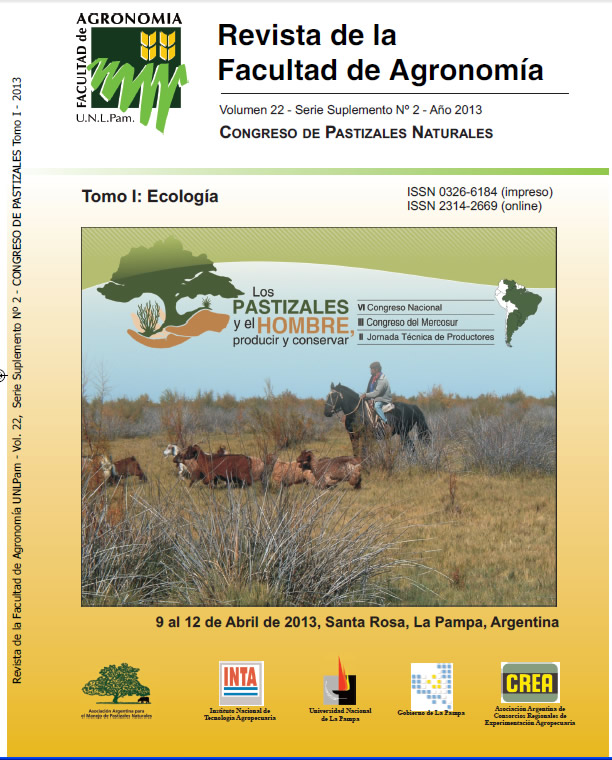Cattle and goat diets under different goat stocking rates on woody invaded buffelgrass pastures
Keywords:
Multi-species grazing, goat stocking rate, diet, shrub encroached pasture, Cenchrus ciliarisAbstract
Buffelgrass (Cenchrus ciliaris L) seeding is a practice currently used for rapid restoration of grass cover on degraded areas at the Arid Chaco region. Invasion of native woody species is a generalized fact on this kind of pasture. Cattle-goat simultaneous grazing could be a strategy to improve vegetation utilization and increase animal production. The objective of this study was to evaluate goat stocking rate effects on diet composition and similarity between cattle and goats during the growing season (November to April) in woody encroached buffelgrass pastures. Three treatments were evaluated (T1=1.00 goat/ha, T2=1.71 goat/ha y T3=2.42 goat/ha). Each treatment was simultaneous grazed by heifers (0.86 head/ha). Fecal samples of 6 goats and 6 heifers were monthly (from December-10-2005 to May-62006) recovered in each treatment. Diet botanical composition was evaluated by microhistological analysis. Within each animal species, differences (p<0.05) were detected in diet composition and similarity among stocking rates. Within each stocking rate, differences (p<0.05) were detected in diet composition between animal species but not (p>0.05) in diet similarity. Results show that, in similar environments to the present study, goat stocking rate is an important factor that affects food selection and that for this reason, it should be considered when designing multispecies grazing strategies for improving vegetation utilization and increasing animal production.
Downloads
References
Anderson D.L., J. del Aguila, A. Marchi, J. Vera, E. Orionte & A. Bernardón. 1980. Manejo Racional de un Campo en la Región árida de Los Llanos de La Rioja. INTA, Buenos Aires, Argentina. pp.90.
Animut G. & A. Goetsch. 2008. Co-grazing of sheep and goats: Benefits and constraints. Small Ruminant Res. 77: 127- 145.
Animut G., A. Goetsch, G. Aiken, R. Puchala, G. Detweiler, C. Krehbiel, R. Merkel, T. Sahlu, L. Dawson, Z. Johnson & T. Gipsonet. 2005. Performance and forage selectivity of sheep and goats cograzing. Grass/forb pastures at three stocking rates. Small Ruminant Res. 59: 203-215.
Blanco L., F. Biurrun & C. Ferrando. 2005. Niveles de degradación de la vegetación del Chaco Árido. Una Aproximación cuantitativa a partir de imágenes satelitales. INTA. Serie de Publicaciones de Investigación EEA La Rioja, Argentina. pp. 12.
Ferrando C., J. Molina, T. Vera & A. Ricarte. 2012. Diet composition of goats and cattle on woody invaded buffelgrass pasture. En Actas II Congreso Nacional de Sistemas Silvopastoriles Ediciones INTA. S. del Estero, Argentina. pp. 22- 27.
Gomez A., P. Peri, R. Renolfi & A. Catán. 2012. Dieta caprina invernal bajo dos cargas en un sistema silvopastoril del Chaco Semiárido. En Actas II Congreso Nacional de Sistemas Silvopastoriles Ediciones INTA. S. del Estero, Argentina. pp 140-146.
Guevara J., R. Stasi, O. Estevez & A. Monge. 1994. Steer diet composition under three perennial grass use intensities on rangeland in Mendoza, Argentina. J. Arid Environ. 28: 351-359.
Hart R.H. 1978. Stocking rate theory and its application to grazing in rangeland. Proceedings 1st. International Rangeland Congress. Denver, Colorado. pp. 547-550.
Holechek J.L. 1984. Comparative contribution of grasses, forbs and shrubs to the nutrition of range ungulates. Rangelands 6: 245-248.
Johnson M., H. Wofford & H. Pearson. 1983. Microhistological techniques for food habits analysis. USDA, Forest Ser., Res. Paper So-199. pp.41
Mellado M., R. Valdez, L. Lara & R. López. 2003. Socking rate effects on goats: A research observation. J. Range Manage. 56: 167-173.
Miñon D., A. Fumagalli & A. Auslender. 1991. Hábitos alimentarios de vacunos y caprinos en un bosque de la región Chaqueña Semiárida. Rev. Arg. Prod. Anim. 11: 275-283.
Morello J., L. Sancholuz & C. Blanco. 1985. Estudio Macroecológico de Los Llanos de la Rioja. Serie del Cincuentenario Administración de Parques Nacionales. Buenos Aires, Argentina. 5:1-53.
Oosting H.J. 1956. The study of plant communities (W.H. Freeman Co Ed.). San Francisco. pp. 560.
Sparks D. & J. Malechek. 1968. Estimating percentage dry weight in diets using a microscopic technique. J. Range Manage. 21: 264-265.
Taylor C.A. 1985. Multispecies Grazing Research Overview (Texas). En: Proceed. Conference Multispecies grazing. Winrock International, Morrilton, AR. pp. 65- 83.
’tMannetje L. 1978. Measuring quantity of grassland vegetation. En: Measurement of Grassland Vegetation and Animal Production (L. ’tMannetje ed.). Bulletin Common wealth Agricultural Bureaux No. 52, Hurley, Berkshire, England. pp. 260.
Downloads
Published
Issue
Section
License
La Editorial de la Universidad Nacional de La Pampa (EdUNLPam) exigirá a los/as autores/as la firma del siguiente documento:
La EdUNLPam lleva a cabo la publicación del artículo: (Título del Artículo) en SEMIÁRIDA Rev.Fac.Agron UNLPam ISSN 2362-4337 (impresa) ISSN 2408-4077 (en línea), del cual el/los abajo firmantes son autores de una o más partes. En el mismo acto, el/los autores entregan exclusivamente a la EdUNLPam todos sus derechos protegidos por las leyes de propiedad intelectual que rigen en la Argentina para reproducir, publicar, editar, fijar, comunicar y transmitir públicamente en cualquier formato o medio impreso o electrónico, inclusive internet, el artículo enviado a publicación e incluirlo en índices o bases de datos nacionales e internacionales. A cambio, la EdUNLPam entrega a los autores la autorización para la publicación o reimpresión con ines académicos y educativos en cualquier libro o medio de divulgación, con la sola obligación de citar el artículo original publicado en la EdUNLPam. Cada autor acuerda en que el material provisto a la EdUNLPam es un trabajo original, que no ha sido impreso o publicado en cualquier otro medio con anterioridad y que no vulnera derechos de terceros. El Primer autor tendrá la posibilidad de leer y corregir el artículo ya editado como “prueba de galera”, pero si el autor no devolviera esas correcciones de la prueba de galera dentro del tiempo especificado, el proceso de producción y publicación podrá proseguir sin la aprobación del autor. El/los autor/es no recibirán compensación monetaria de la EdUNLPam por el uso del material contenido en este artículo y asumen la responsabilidad de las opiniones vertidas en él.






.png)



22.png)



.jpg)




.jpg)
